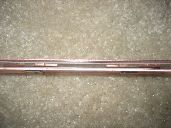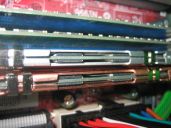|
Vizo Sleet DDR Cooler

Installation and Testing:
The first two images below illustrate the installation process. The protective strip is peeled off of each side and attached to the stick of RAM such that the grooves at the top slide together. Then, the clips are attached just so that you're not entirely relying on the adhesive strips to keep the DDR cooler from falling apart. In fact, once the clips are affixed, removal is nearly impossible without having to break the clip.
Closed, minus RAM |
Attached to RAM |
RAM Installed |
I installed the Sleet DDR Cooler into a pre-existing system and only onto one stick each of RAM out of a cluster such that I could take side by side temperature readings at the same system condition. The first thing I noticed between the copper and aluminum variants is that the copper is significantly heavier, and therefore more dense.
I stressed out the system as much as I could and used a laser-guided temperature reader to take my measurements, and the results were very promising. At a base reading of 44.5C on the bare sticks of RAM, the one with the aluminum DDR Cooler measured 40.5C, and the copper at 39.5C. This is a distinct result that heavily favors this product as a solid cooling agent.
Conclusion:
Considering that the two-pack Vizo Sleet DDR Cooler goes for $11.99 from Newegg for the copper, and only $7.99 for the aluminum, there is no reason not to invest in the Sleet DDR Cooler if you suspect that the RAM is overheating. The one degree difference in my results seems almost negligible at these temperatures, but then again, the difference may increase at higher temperatures. It isn't apparent whether it was due to a difference between the two materials (the copper is more dense), or if it was just due to some kind of anomaly. However, there's no doubt that either choice would be a good choice. After factoring in shipping costs, you may as well just get the copper.







